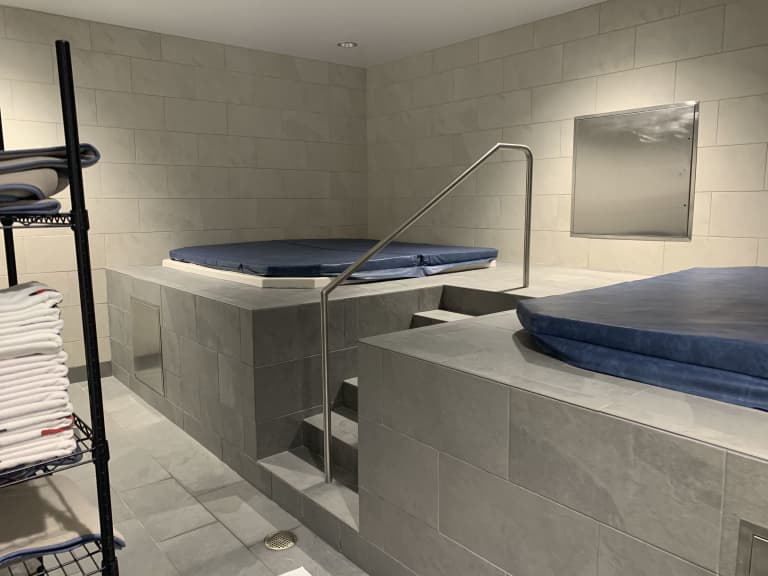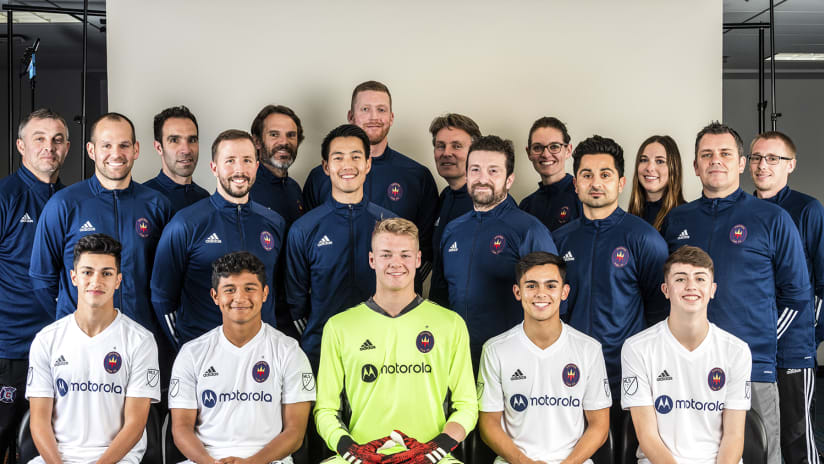I’m standing in the spot where my desk used to be, looking at the far side of the main office floor at SeatGeek Stadium. In an off-season full of logistical mini-miracles, each following the other in such rapid succession as to appear almost routine — I’m experiencing another one. In what used to be a warren of tired cubicles, the ability to gaze across a bright room, uninterrupted, provides a surprising jolt of realization of how much has changed and continues to change for Chicago Fire FC, and how fast.
Quite rightly, this weekend will provide a moment when all of us will turn our attention to the field, and a transformed roster gets its competitive life underway.
It is not only the roster and technical staff that have transformed in the off-season, though — every working environment of the Club has undergone a drastic overhaul, with more to come.
SeatGeek Stadium has been no exception to the changes. Not only did virtually the entire administrative staff move to new offices with a five-times larger footprint, in the Loop, but the offices and locker room areas at SeatGeek have been renovated to be more fit for purpose as a base for the first team and Academy. Additional playing surfaces are on their way as well and will soon be used by Chicago footballers of all ages.
It’s a dramatic shift from the latter days of 2019. In the year I’ve been with the Club I’d seen the staff expand dramatically — only accelerating with Joe Mansueto’s move to sole ownership. Yet the limited office space at SeatGeek Stadium meant that space was not something we had the luxury of re-imagining, it just had to be found, as the head count grew. My own experience was of shunting between three head-height cubicle spots over my first few months, before eventually settling on a former intern’s desk that I first had to clear of three Sparky mascot heads.
Nobody complained — in general our prevailing sentiment was excitement at the talent filling up the cubicles around us. My own desk was at the end of the affectionately named “Marcom Alley”, where 2019 saw 12 new staff arrive to augment the team of marketing, design and communications professionals who are driving everything from social video, to ad campaigns, to our new Spanish language twitter presence @VamosFire.
But from today’s perspective, visiting from a new 50,000 sq ft office space at the heart of the Loop, I’m struck anew by how profound an opportunity everyone at Chicago Fire now has to truly flex creatively as we work, without fear of bruising our elbows. From “Ambition, meet physics,” to “What do you need? Where do you want it?” is a transformative change.
Perhaps no two people better appreciate the transformation than Paul Cadwell and Brian Roberts. “Caddy” has been with the Club for 20 years in multiple capacities, and has overseen the renovation at SeatGeek, while Brian Roberts, the Director of the Club’s innovative Academy PASS program, has seen his department go from a series of desks patchworked together in space left over from other departments to a new standalone symbolic presence at the heart of the Club’s technical life — a place where young players can experience their first taste of what a professional’s day looks like.
Paul and Brian used to share a windowless storage room as an office. It was a desk lamp-lit space that also accommodated Senior Director of Soccer Operations Eddie Rock — and in a further miracle of spatial engineering in late 2019, a spot for new head scout Borja di Matiás Sánchez. I swear I see Borja grin every time I now pass him sitting at the 16-person football ops conference table he likes to commandeer when he’s working at our city center offices. He may be remembering his 3ft round café table from just weeks ago…
“It was a little like a Monty Python sketch” jokes Paul. “All of us on top of each other. So, to see this come together, and see that Joe [Mansueto] never stops thinking and committing to what needs to happen to get us to the next level, I end up getting a little choked up at what’s being delivered for us.”
We’re talking in a new conference room at SeatGeek, dedicated for Academy staff use. It is made up the President’s former office and another windowless room that previously housed several members of the Academy staff. It’s been knocked together to create a long space with windows at one end and a large conference table at the middle. State of the art AV equipment completes the room. Witnessing their athlete’s energy cooped up in the old space used to put me in mind of agitated water molecules being heated up in a kettle. Their track-suited presence appeared out of step with the general administrative vibe of the rest of the front office, but in its awkward location was also prominent enough to emphasize a sense of distance from the first team operations on the ground floor of the stadium.
Now the Academy is its own staging post for young players and their coaches, integrated with the life of the first team. The offices that used to house senior admin staff now form a sweep that takes in Georg Heitz at one end, to Brian Roberts and Academy Director Cedric Catenoy at the other. And the ground floor now includes dedicated academy locker room space and access a greatly enlarged first team gym. Space as an expression of function.
Sitting in his new office, surrounded by inspirational books for young players, Brian Roberts is thrilled at the development.
“We launched a School Day Release (SDR) Program where select academy players are invited to the stadium each Tuesday to train with us for the whole day. We know that individual functional training plays a central role in player development, so instead of four nights a week participating in training in the evening after school, where we are primarily focusing on team play and tactics, we are able to bring players in each Tuesday to take part in double sessions (morning and afternoon) that are built to meet their individual positional needs. We are utilizing the new study area (he indicates what used to be the ticket sales wing) for players to catch up on school work and we provide each player with individual support, whether it’s a private space to receive career or personal counselling (he gestures at what used to be the Game Day Ops office).”
Roberts also emphasizes that this reflects the changing demographics of the team as a whole. “You look at how young our first team roster is going to be this year — we have an increase in the number of 18, 19 and 20 year olds players, as well as a number of homegrown players of a school age. We encourage our younger players to pursue part time university degrees to enhance their cognitive development and provide for a career after football, while we direct our players of school to age complete their high school diploma. A reimagined SeatGeek stadium allows the club to provide space and an improved learning environment for players to pursue their goals, after they step off the field each day.”
I point out to both Brian and Paul that it can only enhance the sense of self-worth and self-image of young players trying to envision how they get to the next step, and how important it will be for them to see that path now visibly baked into the Club’s structure and working life.
“Absolutely,” says Paul. “I had my own time with the academy, and honestly it would have made it so much easier to even speak with coaches of good youth clubs in the area and not to have them say, ‘What can you offer a young player we can’t?’ It’s clear now that beyond just the quality of technical staff, there’s a professional environment for them to grow.”

It ends up being my main takeaway from the visit. The first team facilities are being transformed as well — the former gym is now a screening room, new spa-like pools augment a revamped treatment center, and the influence of new performance director Ben Donachie is clearly visible in the stacks of new gym equipment waiting to be installed. Another former “coaches cave” is now a light-filled war room, thanks to repurposing part of the ticket office. The first team locker room has been expanded too.
But it’s that sense of connection from the Academy to the first team that really resonates, and which chimes with the cultural changes the rest of us are feeling in our new offices in the city center (which also house a wing for the technical staff to meet, plan and work). The challenge and opportunity we all have now is to animate the space we’ve been granted in new and imaginative ways so that our efforts compound each other’s. We can’t guarantee success on the field but we can plan for it and be ready to take full advantage of it in capturing the imagination of the city.
Brian Roberts has one more thought on the transformation. “Before, with the cubicles penning everyone off at head height, you’d be at your desk and you could hear everyone’s conversations — every phone call — but you couldn’t see them. And at the Academy, we were kind of squeezed in to whatever space there was available. And now even though we’re more spread out, you actually get the sense of us all working together and in the right place.”
The field is where this all finds meaning of course. And as the season kicks off, nobody is in any doubt that there’s a lot of work ahead to make sure a transformed working environment translates into transformed fortunes on the field. But when you’re headed towards goal, there’s no doubt it helps to look up and see your teammates.





